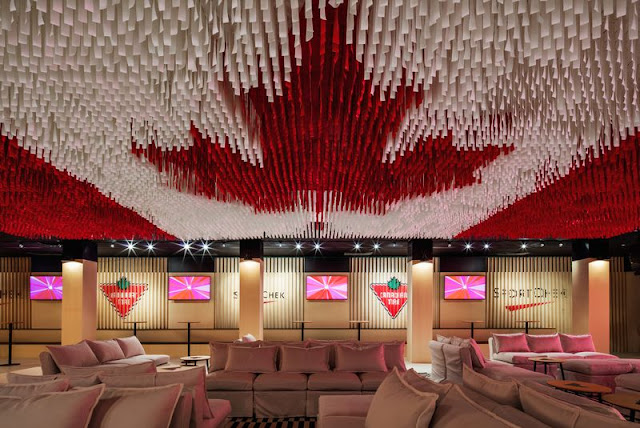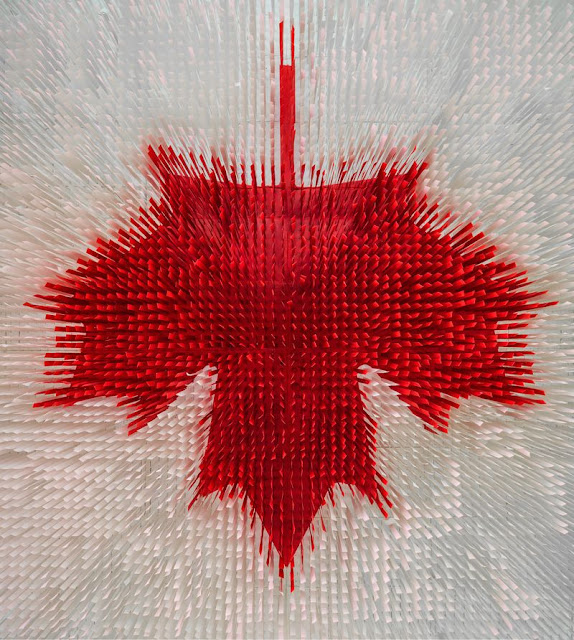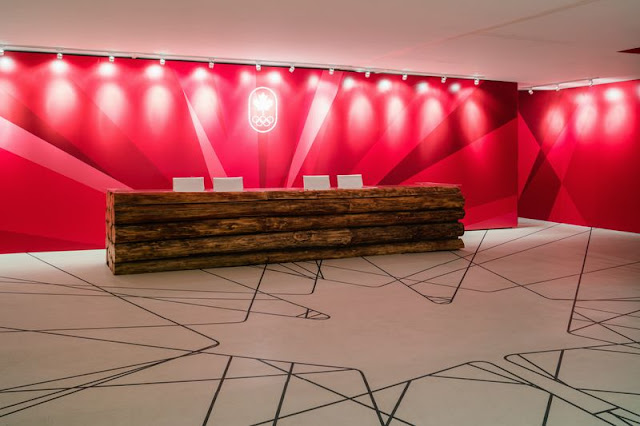Inside Canada’s vibrant Rio Olympic House by Yabu Pushelberg
For the first time ever, the Canada Olympic House, the Rio home base for Canadian Olympians and their friends and family, was designed by Canadians. Ontario natives George Yabu and Glenn Pushelberg, who are best known for their luxury hotel, residential, and commercial interiors like the Four Seasons Toronto and Park Hyatt New York, simply asked the Canadian Olympic Committee: “What can we do for Canadian athletes to showcase their country?” Yabu recalled.
 The deconstructed Canadian flag is made up of hundreds of hanging ribbons.
The deconstructed Canadian flag is made up of hundreds of hanging ribbons.
The duo behind their namesake firm Yabu Pushelberg, which has offices in Toronto and New York, were tasked with transforming a former athletic center from the 1960s into something “hip, modern and truly Canadian.” The Canada House was made possible with the support of Team Canada’s corporate sponsors, but they weren’t pressured to put partner branding front and center.
“Instead of being as commercial as some other houses are, we wanted to, of course, work with the sponsors, but also do things that were artistic, edgy, innovative, and still exude that Canadian easiness, comfort, and realness that we’re all about,” Yabu explained.
Working with a very limited budget and time constraints, Yabu and Pushelberg, who offered their services pro bono, used the opportunity to demonstrate their ability to think out of the box and conceive of a space that was a departure from their usual calling card of sleek, high-end interiors. They conceived of the project as an exhibition installation of sorts, incorporating digital printing, sculpture, art, lighting, and bold graphic design to capture the “straight-forwardness and honest integrity of Canadian lifestyle” and create a “sense of calmness and warmth.”
The space is awash in Canadian iconography that has been transformed to scale or repurposed in fresh ways. For instance, in the Celebration Lounge, a deconstructed Canadian flag by Toronto art studio Moss & Lam is fashioned from hundreds of strips of ribbon dyed red and white suspended from the ceiling, while Muskoka chairs—the Canadian equivalent of the Adirondack—spray-painted ombré in the national colors take up residence, along with hammocks, on the light-canopied terrace.
Presiding over the central, winding staircase is a dynamic mobile-like sculpture of red and white paddles (also by Moss & Lam) featuring maple leaves painted with the help of Canadian Olympians and students from the Etobicoke School of the Arts. Kayak-inspired light fixtures and the use of natural woods and logs also figure throughout the space, contributing to the Canada House’s cozy and playful atmosphere.
While the duo started the design process 18 months ago, they experienced their first impressions of Olympic design as preteens. And when the Summer Games came to Montreal in 1976, Canada was going through a positive time not only politically, but design-wise as well.
“Pierre Trudeau was the prime minister, and Canada was cool at the time; it was a cool, hip, forward-thinking place to be,” Pushelberg said. “It’s interesting how time goes on and all of a sudden his son is now the prime minister of Canada and has this very positive, progressive outlook about the world and Canada’s position in it. This is a great potential time for design in Canada again.”
Images Source: Yabu Pushelberg
















Architecture